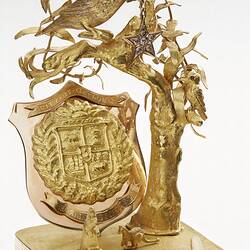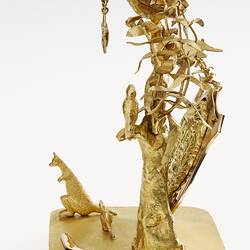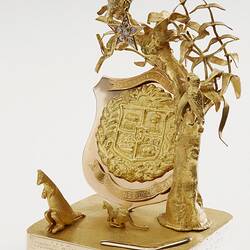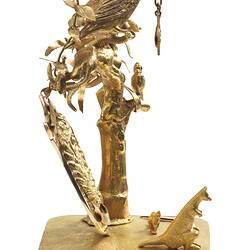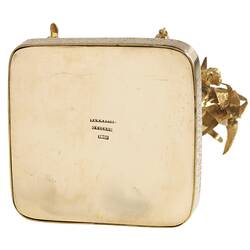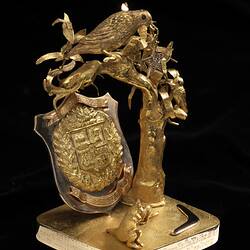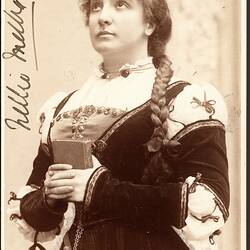Summary
Gold presentation paperweight and original blackwood presentation box, produced by Hammerton & Co., Geelong, 1922.
It was presented by the people of Geelong to Dame Nellie Melba in appreciation for her fundraising efforts for the Kitchener Memorial Hospital in Geelong in 1922. A special concert headlined by Melba was performed at Geelong's His Majesty's Theatre. The programme also included contralto Lilian Gibson, baritone Haigh Jackson, pianist Una Bourne and flautist John Lemmone. Melba sang arias from La Boheme and Otello [Mimi and Desdemona were two of her most popular roles) as well as some popular songs of the day. The Argus newspaper reported on 16 August 1922 that a record amount for a Melba fundraising concert had been raised, with tickets to the value of 7012 pounds sold.
In 1921, on a visit to Geelong, Dame Nellie Melba made a promise to the Mayor Hitchcock to return the following year and perform in a fund raising concert for whatever charity he saw fit. Hitchcock saw great possibilities for the appeal established to raise funds for the new Geelong Hospital, to be known as the Kitchener Memorial Hospital after the English war hero. He decided to aim high, and beat the 6,500 pounds raised by Melba for the Polish Relief Fund in Sydney in 1915, even though their population had been 30 times higher than Geelong.
The Mayor and the Council were able to activate the community, including schools, churches and sporting bodies. Through their hard work and dedication, ticket sales surpassed Sydney's until 7,012 pounds had been raised. The concert was a triumph, including the need to add 450 extra seats on the stage and at the back of the dress circle. Melba sang many of her most famous songs, including a long encore, and received a rapturous and noisy applause.
At the end of the concert, the mayor presented her with this object, described in the Argus newspaper (16th August, 1922) as `a gold paperweight, representing a gum tree with a lark on top, bearing in its mouth a diamond star, inscribed with the letter `M'. The souvenir, which was the work of Messrs J. Hammerton and Sons, was enclosed in a blackwood case'. As this happened, an electric sign was lowered with the words `Geelong Thanks You', as the crowd stood and sang `For She's a Jolly Good Fellow', led by the Geelong City Band. The Argus goes on the report `Dame Nellie Melba acknowledged the gift, and praised Alderman Hitchcock 'I thank you from the bottom of my heart, thank you, thank you.'
Five generations of Hammertons have operated a Jewellery business in Victoria, since John Hammerton began plying his trade as a silversmith, engraver and jeweller in Geelong in 1879. By the turn of the century, his reputation had grown to such an extent that he was producing much of the region's fine jewellery, metal work and presentation pieces. During this time, John was joined by his son Horace, who eventually moved the business to the relatively new and thriving town of Mildura, where his great grandson Ryan still operates. The family has works in several public collections, including the Geelong Art Gallery and the National Gallery of Victoria.
Physical Description
15ct gold paperweight, all moulded, crest plate and boomerang cast, cut and polished. Featuring City of Geelong Coat of Arms attached at bottom point to rectangular base. Also gum tree with branch and leaves. Decorated with a boomerang and Australian native flora and fauna motifs, including a kangaroo, kookaburra and wallaby. A large bird (lark?) on the tree branch holds suspended from its beak a diamond set star pendant, reverse featuring the initial 'M'. Inscription runs around the base. Polished blackwood box hinged and opens to reveal blue silk velvet lining. Maker's label at inside base of box.
Significance
Dame Nellie Melba is one of Australia's most famous cultural icons and exports. Her operatic achievements were acknowledged both nationally and internationally and her World War I fundraising efforts earned her Dame Commander of the British Empire. Born Helen Porter Mitchell in Melbourne in 1861, Melba would maintain a constant affection and connection to her homeland and in particular Melbourne and the Yarra Valley where she would establish her Australian home, Coombe Cottage, from 1909. Melba was also a tireless fundraiser, both during World War I, but also for numerous local causes, from hospitals to conservatoriums.
This collection represents Melba as citizen, resident, fundraiser and community participant. The objects bring together direct connections to Melba with rich stories significant to Melba's broader narrative and to the Museum's collecting areas - such as her World War I fundraising activities, her deeply personal connection to her father David Mitchell, builder of the 1880 Exhibition Building, her attachment to homeland, and her involvement in many local cultural and social activities.
This particular artefact unites a number of key historical themes relating to Melba, Australian iconography, local gold and silver smithing industry, and regional Victorian history. The award was presented to Melba by the people of Geelong for her fundraising efforts for the local hospital. It speaks to the history of Geelong, and also a major local company Hammerton & Sons who had been established in Geelong and Mildura for five generations. The object is an artistic piece in its own right and displays classic 'Australiana' iconography - including native animals and Aboriginal motifs.
More Information
-
Collecting Areas
-
Acquisition Information
Purchase
-
Acknowledgement
Purchased with the assistance of the Sunshine Foundation and the Australian Government through the National Cultural Heritage Account.
-
Maker
J. Hammerton & Sons, Geelong, Greater Geelong, Victoria, Australia, 1922
-
Presented To
-
Inscriptions
Coat of Arms: 'CITY OF GEELONG/BY THE RIGHT USE OF GOD'S GIFTS' Base: 'DAME NELLIE MELBA'S/GRAND PRESENTATION CONCERT./IN AID OF KITCHENER MEMORIAL HOSPITAL/Presented to Dame Nellie Melba D.B.E/by the Citizens of Geelong' Rear of base: (stamp) HAMMERTON GEELONG 15C T'
-
Classification
Recreation & tourism, Performing arts - opera, Awards & presentations
-
Category
-
Discipline
-
Type of item
-
Overall Dimensions
85 mm (Width), 73 mm (Depth), 127 mm (Height)
-
Keywords
Fundraising, Icons, Music, Performances, Performers, Hospital Fundraising, Opera, Souvenirs, Artists, Fundraising, Fundraising Events, Hospitals

